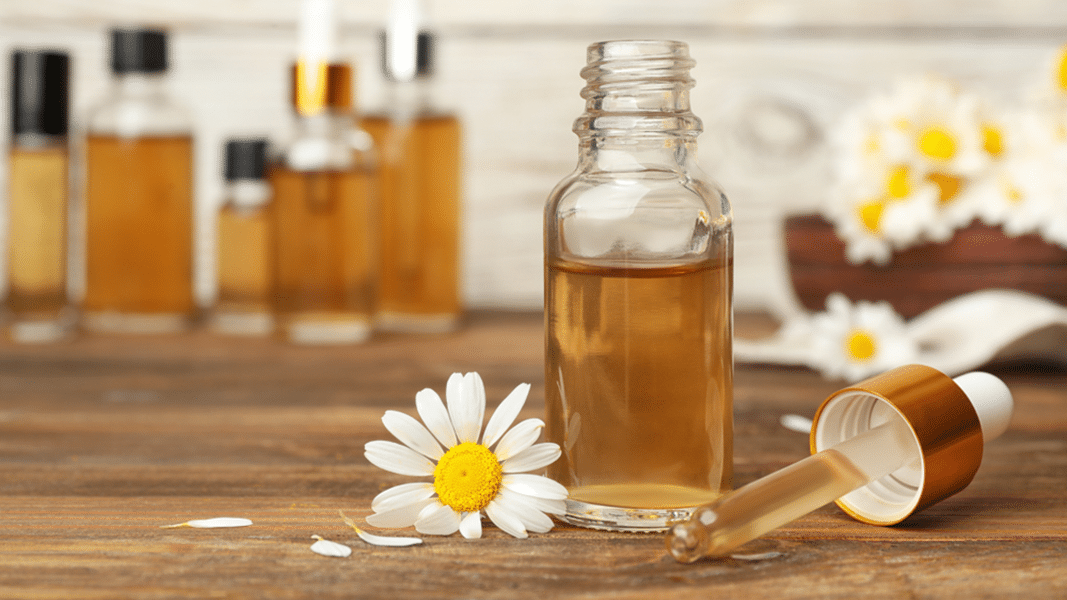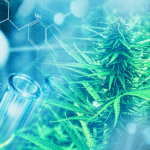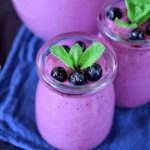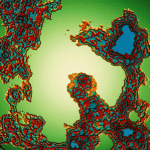Just a few years ago, most of the cannabis-infused topicals and skincare products available were jars of greasy green glop, handmade in someone’s kitchen and smelling suspiciously of bong water. Not so in 2019.
In today’s 17-billion-dollar “prestige beauty” industry, cannabis-infused skincare is the hottest trend since snail mucus, and the non-intoxicating cannabinoid known as cannabidiol (CBD) is its sparkly little darling. CBD is the reason why executives from top outfits like L’oreal and GOOP are leaving lucrative jobs to join forces with cannabis skincare start-ups.
CBD blasted into the entrepreneurial stratosphere after the passage of 2018 Farm Bill, which removed hemp from the Controlled Substances Act and supposedly made it legal to grow, produce and market any part or derivative of a cannabis sativa plant containing a minuscule amount (0.3 percent or less) of tetrahydrocannabinol (THC). These days, CBD-spiked skin products are everywhere. Vogue, Vanity Fair, and Forbes sing their praises. Gwyneth Paltrow and Martha Stewart are big fans. And while it’s not surprising that Bob Marley’s daughter has her own cannabis-infused skincare line, you can also buy CBD-infused lotions, massage oils and lip balms from Amazon or at the mall in stores like Sephora, CVS, and Walmart.
Manufacturers, distributors and investors are flinging themselves onto the CBD bandwagon, while the Food and Drug Administration (FDA) dithers, trying to figure out how to respond to the CBD upsurge. Given the uncertain regulatory environment and the FDA’s qualms about ingestible CBD supplements, topicals are a safer bet for those seeking business opportunities in the CBD market. It appears that the FDA is much less concerned about the safety and efficacy of CBD topicals than CBD edibles and beverages. In general, FDA policy with respect to cosmetics and deodorants is shamefully lax, fostering widespread exposure to carcinogens, endocrine disrupters, and other toxins that pose a serious threat to public health.
Thus, it’s important to carefully scrutinize all the ingredients listed on the label before you drop a couple of Benjamins on CBD-infused facial creams or bath bombs. Don’t assume that it’s a high-quality product just because it contains CBD.
Slick marketing campaigns are touting CBD as a miracle compound for the skin, with healing properties that range from relieving pain to soothing rashes and eradicating acne. The most alluring (and profitable) CBD-related promises pertain to anti-aging and beautifying the skin. But is there anything substantive behind all the hype? Can CBD really protect, heal and restore the skin? What, if anything, does the science say about all this?
Skin, Our 22-Pound Organ
Human skin is a complex, multifunctional, protective barrier for the body. It’s also the heaviest organ we carry around — about one seventh of our total body’s weight, or 8 to 22 pounds on average — with a surface area of about 2 square yards. (Apologies to the rest of the world that measures in terms of meters and kilos.)
The skin is comprised of three layers. The outermost, called the epidermis, is like a fortress wall, a strong-yet-flexible barrier made up of constantly-renewing skin cells known as keratinocytes that shield the body from physical assaults — everything from sunburn and irritating substances to attacks from invading pathogens; from biting and stinging creatures to burns, punctures, cuts, abrasions, and other inflicted traumas.
Below the epidermis is the dermis, which houses a complex collection of nerves and capillaries. Most of the body’s sensory cells (those that feel pressure, heat and cold, touch, vibration and pain) are found here, as well as sweat glands, hair follicles and sebaceous (oil-producing) glands. The dermis is also where collagen and elastin are made, substances that support the epidermal outer layer and gives it that youthful, spring-back-when-pinched quality so coveted by the older set. Seniors are particularly vulnerable to manipulative advertising that banks on society’s obsession with youthfulness to sell beauty products that promise to rejuvenate the skin’s once-glowing exterior.
And then there’s the deepest layer, known as the hypodermis, which attaches the skin to the rest of the body. Composed mostly of fat, connective tissue and water, it helps to insulate the body from temperature extremes and cushions bones and joints. Vitamin D and other essential hormones are synthesized in the hypordermis.
The many different cells contained in all three layers of skin work together in a complex, interconnected, delicately-balanced neuro-immuno-endocrine network that is regulated by the endocannabinoid system (ECS). Comprised of endogenous compounds that bind to cannabinoid receptors (CB1 and CB2), which are expressed in all types of skin cells, the ECS engages in a homeostatic process called cutaneous cannabinoid (“c[ut]annabinoid”) signaling. This signaling mechanism promotes healthy skin renewal and barrier function.
The Skin’s Guardian
The ECS regulates numerous physiological functions, including cellular apoptosis (cell death), a process that allows the body to eliminate aging and damaged cells, enabling regenerated cells to take their place. Cannabinoid receptor signaling can slow abnormally high skin cell production (thereby lowering the likelihood of cancer) and can also soothe the skin’s sensory nerves, reducing pain and inflammation.
The ECS also regulates the activity of pro-inflammatory cytokines and chemokines (proteins in the body involved in immune activity), and helps to maintain the action of Treg cells, a type of T cell that modulates immune response in the skin.
Hungarian scientist Tamas Biro has documented how the ECS influences the production of sebum (the skin’s natural oil), increasing it to keep the skin’s waterproof barrier intact or decreasing it, which helps to keep acne at bay.
A recent report by German scientists in Experimental Dermatology noted that a “disruption of the delicate balance in cannabinoid signaling might facilitate the development of multiple pathological conditions and diseases of the skin such as atopic dermatitis, irritative allergic contact dermatitis, acne, seborrhea, psoriasis, itch, pain, hair growth disorders, systemic sclerosis, and cancer.”
The report goes on to explain how skin barrier dysregulation can delay wound healing and concluded that a “depletion of CB1 or CB2 receptors resulted in enhanced contact allergic inflammation, while cannabinoid receptor activation resulted in a reduction of inflammation.”
Based on their preclinical findings, the report suggests that pharmacological intervention to delay the breakdown (and thereby prolong the action) of endogenous cannabinoid compounds, which activate CB1 and CB2, could be a viable strategy for treating skin disease.
Enemies of Healthy Skin
Most negative aspects of the skin’s appearance are due to years of accumulated damage to cutaneous cells. Wrinkles and roughness, for example, can be caused by environmental and lifestyle factors such as excessive sun exposure, alcohol consumption, smoking, and poor diet. In addition to these epigenetic intrusions, the dryness common in a mature woman’s skin is associated with the drop in hormone production that occurs after menopause. All of these factors can cause biochemical changes in our cells’ DNA, which in turn can trigger DNA methylation, a process that alters the function and expression of genes in our skin and throughout the body.
Let’s face it, as we age, everything slows down and becomes less efficient, including our skin’s ability to generate the fresh new cells that give us that healthy, youthful look we took for granted during all those summers on the beach, when the only sun block we wore was a bikini.
As we get older, our cellular functions start to go a little haywire. And when this starts showing up on our faces, it can be truly sobering. There’s even a scientific term for time’s cruel ravages upon the body: inflammaging, the continuous, low-grade inflammation associated with aging. A 2019 article in the journal Cosmetics linked many skin conditions with such inflammation, and suggested that natural, anti-inflammatory compounds might help.
Some people will do crazy things to themselves in hopes of slowing down the inevitable decline that occurs with aging. But consider other options for restoring skin function and appearance before you go shooting your face with laser beams, injecting it with tiny spheres of polymethylmethacrylate or sandblasting it with diamond-shaped crystals.
Maybe there’s some hope-in-a-bottle you could try, thanks to cannabis.
CBD Isolate or CBD Oil?
Cannabis-infused skincare has a long history. According to Dr. Eduardo Muñoz, professor of immunology at the University of Cordoba in Spain, topical preparations of cannabis were used to treat various skin disorders in ancient China, Egypt, and the Arab world. Unlike the dubious efforts of some U.S. and British women of yore, who tried to beautify their skin by ingesting arsenic tablets, for example, or applying lead-based face paint, there are no known side effects from using topical cannabis.
Pure CBD has demonstrated anti-inflammatory activity in preclinical models of skin inflammation. But how does the efficacy of single-molecule CBD in a topical compare to a full spectrum CBD-rich oil extract containing hundreds of other cannabis compounds?
A 2019 in vitro study by Italian scientists in Phytotherapy Research found that the anti-inflammatory impact of cannabis oil exceeded that of pure CBD, indicating that compounds other than CBD contribute to the inhibition of pro-inflammatory triggers in the skin. The Italian team determined that the cannabis oil downregulated several genes involved in wound healing and skin inflammation, whereas the anti-inflammatory effect conferred by the CBD isolate did not involve the same molecular mechanisms.
Since CBD can calm inflammation, it makes sense that it might be a useful ingredient in topical skincare products. But can CBD penetrate human skin deeply enough to really make a difference? A recent in vivo study by University of Kentucky scientists suggests that it can.
Published in the European Journal of Pain, this report found that a topical gel containing CBD significantly reduced pain and inflammation in a rodent model of arthritis. Moreover, it appears that CBD is much more permeable through the skin than THC. According to a 2004 article in the Journal of Pharmacy and Pharmacology, the transdermal permeability of cannabidiol is 10-fold higher than delta-8 THC. (The permeability of delta-9 THC is very similar to that of delta-8 THC.)
The Hundred-Dollar CBD Face Cream Question
So, should you buy a CBD skincare product? It depends. Just because a product has a fancy label and a high price doesn’t mean it will deliver what it claims. CBD products are still unregulated by the FDA, and according to a report in the Journal of the American Medical Association (JAMA), a significant number of CBD products surveyed contained less of the compound than labeled.
A lot depends on what else is in a CBD-infused topical. CBD skincare products may include a “full spectrum” cannabis oil extract containing CBD, THC, and all inherent cannabinoids, fatty acids, and terpenes, which combine synergistically to create a therapeutic entourage effect that’s greater than the impact of CBD alone. Or a skincare salve might contain an infusion of “broad spectrum” cannabis oil without any THC. Or, more likely, it will include a less effective CBD isolate that could be synthetic or naturally-sourced.
Keep in mind that studies on how CBD and other cannabis compounds affect the skin are mostly pre-clinical. Randomized, controlled clinical trials have yet to verify anecdotal accounts (and marketing claims) of CBD’s efficacy for skin ailments. Given the paucity of clinical research, it’s hard to know exactly how many milligrams of CBD per milliliter would be optimal for a skincare product or what a recommended dose should be.
So, if you decide to try a CBD skincare product, do your own research first. Buy from a reputable source – preferably one with a good track record of making cannabis-infused products from organically-sourced ingredients. If possible, make sure it’s third-party lab-tested for consistency and purity. Or you might also consider making your own CBD topical.
Part 2: How to Make a CBD Topical for Healthy Skin
Melinda Misuraca is a Project CBD contributing writer with a past life as an old-school cannabis farmer specializing in CBD-rich cultivars. © Copyright, Project CBD. May not be reprinted without permission.
Sources
- Akhmetshina A, Dees C, Busch N, Beer J, Sarter K, Zwerina J, Zimmer A, Distler O, Schett G, Distler JH. The cannabinoid receptor CB2 exerts antifibrotic effects in experimental dermal fibrosis. Arthritis Rheum. 2009 Apr;60(4):1129-36. doi: 10.1002/art.24395.
- DC, Zhang LP, Ma F, Abshire SM, McIlwrath SL, Stinchcomb AL, Westlund KN. Transdermal cannabidiol reduces inflammation and pain-related behaviours in a rat model of arthritis. Hammell. Eur J Pain. 2016 Jul;20(6):936-48. doi: 10.1002/ejp.818. Epub 2015 Oct 30.
- Derakhshan N, Kazemi, M. (2016). Cannabis for Refractory Psoriasis-High Hopes for a Novel Treatment and a Literature Review. Current clinical pharmacology. 11. 10.2174/1574884711666160511150126.
- Fuller, Bryan. (2019). Role of PGE-2 and Other Inflammatory Mediators in Skin Aging and Their Inhibition by Topical Natural Anti-Inflammatories. Cosmetics. 6. 6. 10.3390/cosmetics6010006
- Gaffal E, Glodde N, Jakobs M, Bald T, Tüting T. Cannabinoid 1 receptors in keratinocytes attenuate fluorescein isothiocyanate-induced mouse atopic-like dermatitis. Exp Dermatol. 2014 Jun;23(6):401-6. doi: 10.1111/exd.12414
- Kupczyk P, Reich A, Szepietowski JC. Cannabinoid system in the skin – a possible target for future therapies in dermatology. Exp Dermatol. 2009 Aug;18(8):669-79. doi: 10.1111/j.1600-0625.2009.00923.x. Review.
- Marks DH, Friedman A. The Therapeutic Potential of Cannabinoids in Dermatology. Skin Therapy Lett. 2018 Nov;23(6):1-5.
- Mounessa JS, Siegel JA, Dunnick CA, Dellavalle RP. The role of cannabinoids in dermatology. J Am Acad Dermatol. 2017 Jul;77(1):188-190. doi: 10.1016/j.jaad.2017.02.056. Epub 2017 Apr 14.
- Oláh A, Tóth BI, Borbíró I, Sugawara K, Szöllõsi AG, Czifra G, Pál B, Ambrus L, Kloepper J, Camera E, Ludovici M, Picardo M, Voets T, Zouboulis CC, Paus R, Bíró T. Cannabidiol exerts sebostatic and antiinflammatory effects on human sebocytes. J Clin Invest. 2014 Sep;124(9):3713-24. doi: 10.1172/JCI64628. Epub 2014 Jul 25.
- Proksch E, Soeberdt M, Neumann C, Kilic A, Abels C. Modulators of the endocannabinoid system influence skin barrier repair, epidermal proliferation, differentiation and inflammation in a mouse model. Exp Dermatol. 2019 Jul 27. doi: 10.1111/exd.14012. [Epub ahead of print]
- Ramesh G, MacLean AG, Philipp MT. Cytokines and chemokines at the crossroads of neuroinflammation, neurodegeneration, and neuropathic pain. Mediators Inflamm. 2013;2013:480739. doi: 10.1155/201¾80739. Epub 2013 Aug 12. Review.
- Río CD, Millán E, García V, Appendino G, DeMesa J, Muñoz E. The endocannabinoid system of the skin. A potential approach for the treatment of skin disorders. Biochem Pharmacol. 2018 Nov;157:122-133. doi: 10.1016/j.bcp.2018.08.022. Epub 2018 Aug 20. Review.
- Sangiovanni E, Fumagalli M, Pacchetti B, Piazza S, Magnavacca A, Khalilpour S, Melzi G, Martinelli G, Dell’Agli M. Cannabis sativa L. extract and cannabidiol inhibit in vitro mediators of skin inflammation and wound injury. Phytother Res. 2019 Aug;33(8):2083-2093. doi: 10.1002/ptr.6400. Epub 2019 Jun 27.
- Ständer S, Schmelz M, Metze D, Luger T, Rukwied R. Distribution of cannabinoid receptor 1 (CB1) and 2 (CB2) on sensory nerve fibers and adnexal structures in human skin. J Dermatol Sci. 2005 Jun;38(3):177-88.
- Stinchcomb AL, Valiveti S, Hammell DC, Ramsey DR. Human skin permeation of Delta8-tetrahydrocannabinol, cannabidiol and cannabinol. J Pharm Pharmacol. 2004 Mar;56(3):291-7.
- Tóth KF, Ádám D, Bíró T, Oláh A. Cannabinoid Signaling in the Skin: Therapeutic Potential of the “C(ut)annabinoid” System. Molecules. 2019 Mar 6;24(5). pii: E918. doi: 10.3390/molecules24050918. Review.
- Turcotte C, Blanchet MR, Laviolette M, Flamand N. The CB(2) receptor and its role as a regulator of inflammation. Cell Mol Life Sci. 2016 Dec;73(23):4449-4470. Epub 2016 Jul 11. Review.
- Zhuang, Yong & Lyga, John. (2014). Inflammaging in Skin and Other Tissues – The Roles of Complement System and Macrophage. Inflammation & Allergy-Drug Targets (Formerly Current Drug Targets – Inflammation & Allergy). 13. 10.2174/1871528113666140522112003.








